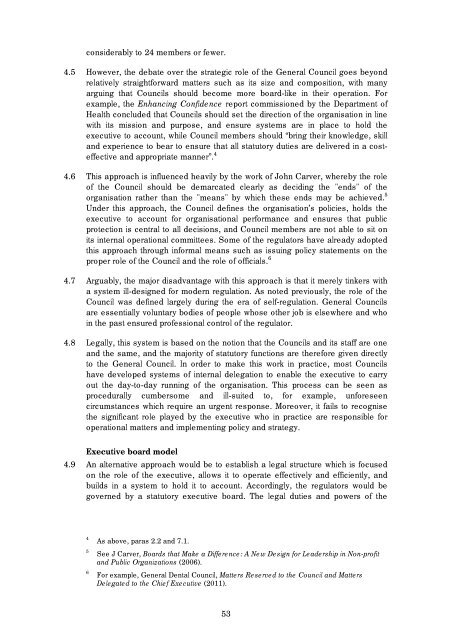Regulation of Health and Social Care Professionals Consultation
Regulation of Health and Social Care Professionals Consultation
Regulation of Health and Social Care Professionals Consultation
You also want an ePaper? Increase the reach of your titles
YUMPU automatically turns print PDFs into web optimized ePapers that Google loves.
considerably to 24 members or fewer.<br />
4.5 However, the debate over the strategic role <strong>of</strong> the General Council goes beyond<br />
relatively straightforward matters such as its size <strong>and</strong> composition, with many<br />
arguing that Councils should become more board-like in their operation. For<br />
example, the Enhancing Confidence report commissioned by the Department <strong>of</strong><br />
<strong>Health</strong> concluded that Councils should set the direction <strong>of</strong> the organisation in line<br />
with its mission <strong>and</strong> purpose, <strong>and</strong> ensure systems are in place to hold the<br />
executive to account, while Council members should “bring their knowledge, skill<br />
<strong>and</strong> experience to bear to ensure that all statutory duties are delivered in a costeffective<br />
<strong>and</strong> appropriate manner”. 4<br />
4.6 This approach is influenced heavily by the work <strong>of</strong> John Carver, whereby the role<br />
<strong>of</strong> the Council should be demarcated clearly as deciding the "ends" <strong>of</strong> the<br />
organisation rather than the "means" by which these ends may be achieved. 5<br />
Under this approach, the Council defines the organisation’s policies, holds the<br />
executive to account for organisational performance <strong>and</strong> ensures that public<br />
protection is central to all decisions, <strong>and</strong> Council members are not able to sit on<br />
its internal operational committees. Some <strong>of</strong> the regulators have already adopted<br />
this approach through informal means such as issuing policy statements on the<br />
proper role <strong>of</strong> the Council <strong>and</strong> the role <strong>of</strong> <strong>of</strong>ficials. 6<br />
4.7 Arguably, the major disadvantage with this approach is that it merely tinkers with<br />
a system ill-designed for modern regulation. As noted previously, the role <strong>of</strong> the<br />
Council was defined largely during the era <strong>of</strong> self-regulation. General Councils<br />
are essentially voluntary bodies <strong>of</strong> people whose other job is elsewhere <strong>and</strong> who<br />
in the past ensured pr<strong>of</strong>essional control <strong>of</strong> the regulator.<br />
4.8 Legally, this system is based on the notion that the Councils <strong>and</strong> its staff are one<br />
<strong>and</strong> the same, <strong>and</strong> the majority <strong>of</strong> statutory functions are therefore given directly<br />
to the General Council. In order to make this work in practice, most Councils<br />
have developed systems <strong>of</strong> internal delegation to enable the executive to carry<br />
out the day-to-day running <strong>of</strong> the organisation. This process can be seen as<br />
procedurally cumbersome <strong>and</strong> ill-suited to, for example, unforeseen<br />
circumstances which require an urgent response. Moreover, it fails to recognise<br />
the significant role played by the executive who in practice are responsible for<br />
operational matters <strong>and</strong> implementing policy <strong>and</strong> strategy.<br />
Executive board model<br />
4.9 An alternative approach would be to establish a legal structure which is focused<br />
on the role <strong>of</strong> the executive, allows it to operate effectively <strong>and</strong> efficiently, <strong>and</strong><br />
builds in a system to hold it to account. Accordingly, the regulators would be<br />
governed by a statutory executive board. The legal duties <strong>and</strong> powers <strong>of</strong> the<br />
4 As above, paras 2.2 <strong>and</strong> 7.1.<br />
5<br />
See J Carver, Boards that Make a Difference: A New Design for Leadership in Non-pr<strong>of</strong>it<br />
<strong>and</strong> Public Organizations (2006).<br />
6 For example, General Dental Council, Matters Reserved to the Council <strong>and</strong> Matters<br />
Delegated to the Chief Executive (2011).<br />
53
















